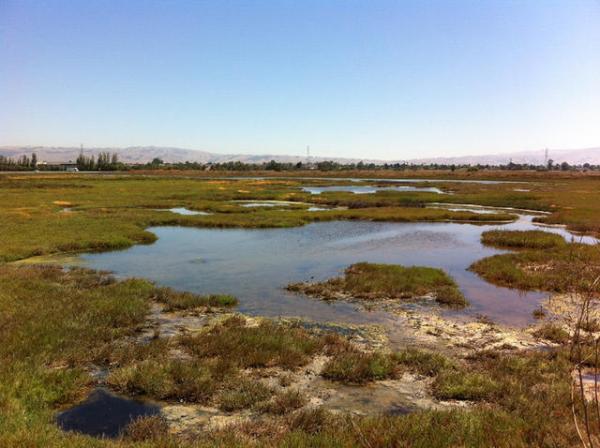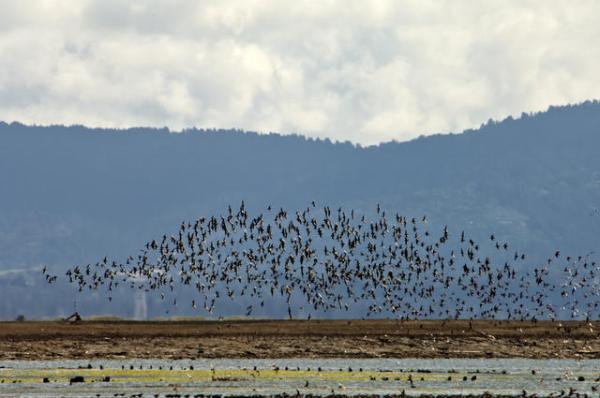The South Bay Salt Pond Restoration Project is the largest tidal wetland restoration project on the West Coast. When complete, the restoration will convert 15,100 acres of commercial salt ponds at the south end of San Francisco Bay to a mix of tidal marsh, mudflat and other wetland habitats. The property was purchased by the State of California and the Federal government from Cargill Salt as part of a larger land transaction that includes 1,400 acres of salt crystallizer ponds on the east side of the Napa River. The acquisition of the South Bay salt ponds provides an opportunity for landscape-level wetlands restoration, improving the physical, chemical, and biological health of the San Francisco Bay.
Frequently Asked Questions
Here you can find a list of answers to some commons questions.
What is the South Bay Salt Pond Restoration Project?
What are the goals of the Project?
The goals are to restore and enhance a mix of wetland habitats, to provide wildlife-oriented public access and recreation, and to provide for flood management in the South Bay. See the Project Goals and Objectives.
Who is managing the Project?
The Project Management Team is comprised of the California State Coastal Conservancy (SCC), the California Department of Fish and Wildlife (DFW), the U.S. Fish and Wildlife Service (FWS), Santa Clara Valley Water District (SCVWD), Alameda County Flood Control and Water Conservation District (ACFCWCD), and the U.S. Army Corps of Engineers (USACE), as well as the Lead Scientist and Collaborative Process Coordinator. The Project Management Team is overseeing the restoration planning process which includes habitat restoration, public access, and flood management, and reports to the Executive Leadership Group, made up of high level representatives from DFG, FWS, and SCC. A Memorandum of Understanding (MOU) between the SCC, FWS, and DFG was signed on May 28, 2003 and outlined roles and responsibilities. A second MOU that includes SCVWD and ACFCWCD was signed on August 26, 2004. The Project Management Team has adopted a decision making structure for all of the parties involved in the planning and restoration process.
What are the plans for funding implementation, how much will implementation cost, and are there mitigation opportunities?
Currently, the Project Management Team plans for restoration to be funded by public agencies and foundations. Based on other restoration projects in the Bay Area and depending on the level of construction work needed, the cost could range from the low hundreds of millions to the high hundreds of millions over many decades. Resource and regulatory agencies will decide whether or not some of the implementation funds will come from project sponsors seeking to mitigate impacts to habitats in other parts of the San Francisco Bay.
What are the differences between tidal marsh and managed ponds and what are the wildlife benefits for each in the South San Francisco Bay?
Tidal Marshes are vegetated wetlands that regularly receive some tidal action. High quality tidal marshes contain intricate networks of channels through which the tides move in and out of the marsh complex. Tidal marshes in the San Francisco Bay provide critical habitat for an array of species, including young salmon and steelhead trout, shorebirds and waterfowl that forage in the salt pannes, harbor seals who "haul out" on the marshes to breed and raise their young, and endangered birds and mammals like the endangered California clapper rail and salt marsh harvest mouse who live only in tidal marshes in the Bay. Managed ponds are shallow open water habitat with no tidal flow or managed tidal flow. These wetlands contain water all or part of the year, have various salinities, and provide feeding and roosting (resting) areas for waterfowl, shorebirds, and other waterbirds. The specific types of birds feeding in a pond depend on the specific conditions in the pond. For example, shorebirds and dabbling ducks like shallow ponds while diving ducks prefer deep water. Certain birds like to feed on brine shrimp and brine flies, which only live in higher salinity ponds, while other birds prefer small fish, which live in the lower salinity ponds. See Fact Sheet #3 for a description of the different habitats in the project area and their benefits to wildlife. Also see the Syntheses of Scientific Knowledge for Maintaining and Improving Functioning of the South Bay Ecosystem and Restoring Tidal Salt Marsh and Associated Habitats over the Next 50 Years at Pond and Pond Complex Scales (PDF).
How will changes in habitats in the South Bay affect endangered species, migratory bird populations, and other wildlife?
The Project Management Team expects that restoration of a portion of the salt ponds to tidal marsh and management of the remainder of ponds will benefit a greater diversity of wildlife, particularly endangered species, such as the California clapper rail, the salt marsh harvest mouse and several fish and aquatic species. Managed ponds will continue to provide important feeding and resting habitat for migratory shorebirds and waterfowl-a function that is already provided by some of the existing salt ponds. The alternative development process has included identification of evaluation criteria for wildlife and analysis of how each alternative meets the evaluation criteria. Benefits and impacts of each alternative to wildlife will be described in the EIR/EIS. See the Synthesis of Scientific Knowledge for Managing Salt Ponds to Protect Bird Populations.
What is the difference between the "initial stewardship" and the "long-term restoration" and how do the two processes relate?
As Cargill phased out salt production, DFG and FWS began initial stewardship of the salt ponds. The objectives of initial stewardship were to protect the existing habitat values of the acquired ponds and to maintain the property so that it could be restored later on. See Initial Stewardship for more information. The long-term restoration plan for the salt ponds was developed while initial stewardship took place. The long-term restoration plan outlines the mix of habitats to be restored or enhanced in the South Bay, and the associated flood management measures and public access improvements, the first phase of implementation of the restoration project, and the adaptive management plan.
What type of environmental review has the Project undergone?
The Project is subject to both the California Environmental Quality Act (CEQA) and the National Environmental Protection Act (NEPA), which are state and federal laws, respectively, that require projects to be reviewed for their potential environmental impacts. Once potential environmental impacts are identified, the laws require project sponsors to identify ways to avoid, minimize, and, if necessary, mitigate the impacts, where feasible. The Project has produced a joint Environmental Impact Report (EIR), as required by CEQA, and Environmental Impact Statement (EIS), as required by NEPA. View the Final EIS/R.
Has funding for all stages of the Project been secured?
Acquisition: Acquisition of the 16,500 acres of salt ponds and associated habitats in the South Bay and along the Napa River was funded with $72 million from the State Wildlife Conservation Board, $8 million from the U.S. Fish and Wildlife Service, and $20 million from the Hewlett, Packard, and Moore Foundations and the Goldman Fund.
Restoration: Funds for implementation of the restoration, flood management, and public access plan to date have come from a mix of sources, including local, state, and federal funds, as well as private funds.



